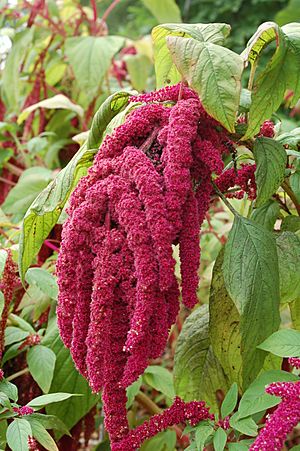Love-lies-bleeding facts for kids
Quick facts for kids Love-lies-bleeding |
|
|---|---|
 |
|
| Amaranthus caudatus growing in the Botanical Garden, Bremen | |
| Scientific classification | |
| Genus: |
Amaranthus
|
| Species: |
caudatus
|
| Synonyms | |
|
List
|
|
Amaranthus caudatus is a type of plant that grows new every year. It has many fun common names like love-lies-bleeding, pendant amaranth, tassel flower, velvet flower, foxtail amaranth, and quilete.
This plant is special because many of its parts are good to eat! People often use its leaves and seeds as food. It's a popular food source in India and South America. In South America, especially in the Andean region, it's a very important plant called kiwicha.
Amaranthus caudatus originally comes from warm, tropical parts of America. The exact place it first grew is not fully known. The beautiful red color you see in its flower clusters comes from natural pigments called betacyanins. These are the same colors found in other related plants, like the "Hopi red dye" amaranth.
Long ago, during the Victorian era, people used flowers to send secret messages. Each flower had a special meaning. The love-lies-bleeding flower meant "hopeless love" or "hopelessness" in this special language of flowers.
Growing Love-Lies-Bleeding Plants
This plant is quite easy to grow! Amaranthus caudatus can reach a height of about 3 to 8 feet (1 to 2.4 meters). It grows best when it gets lots of sunlight. It can also handle different weather conditions, both wet and dry. You can easily grow it from its seeds.
In most places, people plant it as a summer plant. If you live in a cooler area, you can start the seeds indoors in early spring. Then, once the danger of frost is gone, you can move the young plants outside.
See Also

